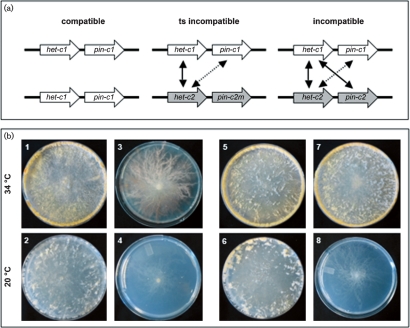Fig. 1.
het-c and pin-c genetic interactions during HI. (a) Interactions between het-c and pin-c are required for nonself recognition (arrows), while interactions between het-c1 and het-c2 contribute to the severity of the HI phenotype (Kaneko et al., 2006). The het-c2–pin-c1 interaction is naturally temperature-sensitive (shown by dotted arrows). (b) Heterokaryons carrying identical alleles at het-c and pin-c show no genetic interactions and are fully compatible at all temperatures (plates 1 and 2; FGSC 4564+FGSC 6103). Heterokaryons of alternate het-c pin-c haplotype (het-c1 pin-c1+het-c2 pin-c2) are incompatible at all temperatures (plates 3 and 4; FGSC 4564+JH1). The temperature-sensitive incompatible (TS inc) heterokaryon (het-c1 pin-c1+het-c2 pin-c2m) is fully compatible at 34 °C, but is incompatible at 20 °C (plates 7 and 8; XK81+FGSC 456). Plates 5 and 6 contain a compatible heterokaryon (het-c2 pin-c2 +het-c2 pin-c2m; XK81+Xa-3).

